|

 Up
Up 
 Showing the
Showing the
World

(You are here.)
 Down
Down




  Need
to Need
to
find your
bearings?
Try
these
navigation aids:
If
this is your first
visit, please stop by:
Something
to share?
Please:



|
|
Available in Française, Español, Português, Deutsch, Россию,
中文,
日本, and others.
 any
good and useful inventions die before they get off the ground. It is a sad fact that most
inventors, while they have the vision and intelligence to create something
new, don't often have what it takes to promote it. And despite the
old saw, the world will not beat a path to your door just because
you've built a better mousetrap. Consequently, many inventions never find
their way to the people for whom they were intended. Their bright promise fades
as the inventors become frustrated, then discouraged, then give up and
move on. any
good and useful inventions die before they get off the ground. It is a sad fact that most
inventors, while they have the vision and intelligence to create something
new, don't often have what it takes to promote it. And despite the
old saw, the world will not beat a path to your door just because
you've built a better mousetrap. Consequently, many inventions never find
their way to the people for whom they were intended. Their bright promise fades
as the inventors become frustrated, then discouraged, then give up and
move on.
Fortunately for the millions of people who travel by air or make their
living in the aerospace industry, this wasn't the case with the airplane.
After spending seven years in difficult and dangerous work to perfect their
invention, the Wright brothers were willing to spend three more to get it
to market. But they found that the marketing, in many ways, was more difficult and required
more fortitude than the actual inventing.
Engineering is a straightforward process that yields unambiguous
results — the airplane either flies or it doesn't. Promotion is just the
opposite. It is a convoluted process, dependent on guesswork. The results
are rarely clear cut; success depends as much on persistence and
serendipity as it does intelligence and strategy. The Wrights found
this out almost as soon as they perfected a practical airplane. They
wrote their congressman and made their invention known to the most likely
customer — the U.S. Army. When the Army replied that it was not
interested, not only was the response disappointing, it also seemed to make no
sense. If the Army had no interest in a flying machine, why had they
poured thousands of dollars into Langley's Aerodrome project?
The Wrights shrugged off the response and headed for Europe, where they
figured a government somewhere would want a flying machine. Once
again, they were wrong. The politics was worse in Europe that it was in
the States, and all the deals they tried to make collapsed. But their
persistence eventually won out. A chance meeting with an American soldier in France
started a chain reaction that finally woke the U.S. Army to the fact that
their native sons were trying to sell a priceless technology with military
applications to foreign powers. They issued an order for an airplane just as a group
of private financiers came together in France to license the Wright
patents. Persistence had paid off handsomely — the Wrights suddenly had
not one but two interested customers.
Now all that remained was to show the world that they could do what
they said they could do.
Timeline:
-
1905 to Spring 1906 — The Wrights offer their airplane to the
U.S. Army and are told the Army is not interested — twice. They try to
sell it overseas, but have no luck there. The only encouragement they
have is that the government finally grants them a patent.
-
Summer and Fall 1906 — While the Wrights are having no luck
selling their aircraft, the French begin to make short hops. Santos-Dumont
manages to fly his 14 bis 726 feet — almost as far as the Wrights
flew in 1903.
-
Winter 1906 to Fall 1907 — The U.S. Army and the French finally
express some interest in the Wright airplane. The Wrights go to France,
but find themselves hopelessly entangled in politics. Returning home, they
find the news more encouraging — the Army finally wants to talk turkey.
-
Fall 1907 to Spring 1908 — Alexander Graham Bell organizes the
Aerial Experiment Association to build airplanes. One of its members is
motorcycle manufacturer Glenn Curtiss. Their first airplane flies 318
feet; the second, 1017 feet.
- Fall 1907 to Winter 1908 — Henri Farman develops an airplane
capable of flying 1/2 mile. He flies the first circle in France, making
wide, flat, uncoordinated turns and wins the Grand Prix de Aviation.
-
Winter and Spring 1908 — The Wrights arrive at an agreement with
both the U.S. Army and the French. They adapt their 1905 Flyer to carry
two people and make the first passenger flights (carrying mechanic Charlie
Furnas). Wilbur leaves for France, while Orville stays behind to build an
airplane for the Army.
-
Summer 1908 — The Aerial Experiment Association builds their
third airplane and the first designed by Glenn Curtiss — the June
Bug. It wins the Scientific American Trophy for the first
"official" flight in America of 1 kilometer.
-
Summer 1908 — Wilbur discovers the airplane shipped to him in
France is badly damaged and he spends most of the summer rebuilding it.
Meanwhile, he is chided in the press as a bluffer. But on August 8, he
makes his first public flight in Europe, astounding the French
audience.
-
Fall 1908 — Orville finishes the Military Flyer and begins to
put it through its paces for the U.S. Army at Fort Meyer, Virginia.
Things go well at first, but while carry passenger Lt. Thomas Selfridge,
a propeller breaks and the Flyer crashes. Orville suffers a broken leg
and Lt. Selfridge is killed.
-
Fall and Winter 1908 — Wilbur is at first paralyzed at the news
of Orville's accident, then shakes it off an begins to fly further and
higher than ever before, setting record after record in France. On the
last day of the year, he makes a flight of over 2 hours to capture the Coupe
de Michelin trophy.
-
Winter and Spring 1909 — Still convalescing from his accident,
Orville joins Wilbur in France, escorted by their sister Katharine. Wilbur
transfers operations to Pau in southern France where the weather is
better, then makes a series of flights in Italy. The Wright are the toast
of Europe. In late April, they reluctantly leave and sail for America.
-
Spring and Summer 1909 — The Wrights arrive home to find they
have become celebrities in America as well as Europe. They are treated to
an endless series of awards and honors, including a city-wide homecoming
celebration in Dayton, Ohio. They spend what little spare time they can
find building a new Military Flyer.
-
Summer 1909 — The Wrights take their new airplane back to
Fort Myer, Virginia and complete the trials that had been interrupted almost
a year earlier. The U.S. Army purchases its first military aircraft for
$30,000.
-
Summer 1909 — The Wrights' sale of the first military flying
machine is overshadowed by news from France. Louis Bleriot, flying a small
monoplane of his own design, has crossed the English Channel. Although it
is a relatively short flight, Bleriot has conquered an important physical
and national boundary. Suddenly, people begin to realize the importance of
this new invention.
-
Summer 1909 — Glenn Curtiss joins with Augustus Herring to
create an airplane manufacturing company, and sells his first aircraft —
the Golden Flyer — to the Aeronautical Society of Long Island,
New York. The Wrights file a suit against Curtiss and other airplane manufacturers
who are infringing on their patent.
-
Summer 1909 — Glenn Curtiss is the only American entry at the
Reims Air Meet in France — the first international gathering of
aviators and airplanes. He captures the Gordon Bennett Trophy for
the fastest airplane and is an instant hero on both sides of the
Atlantic. His fame raises his reputation as an aircraft builder to an even
par with the Wrights.
-
Fall 1909 — Both Curtiss and the Wrights are invited to fly for
the Hudson-Fulton Celebration in New York, New York. Unable to fly his
underpowered aircraft in the heavy winds, Curtiss defaults. Wilbur Wright
shows him up, flying around the Statue of Liberty then up the Hudson River
to Grant's Tomb and back. Over a million Americans see him fly.
Note: You may also want to consult the
Wright Timeline. |
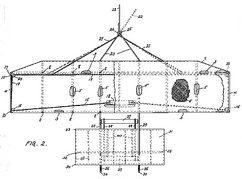
The patent drawings for the Wright's 1906 patent, the
grandfather patent of the airplane.
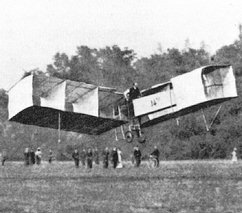
Alberto Santos-Dumont flies the
14 Bis before a
crowd in Paris, France on 23 October 1906.
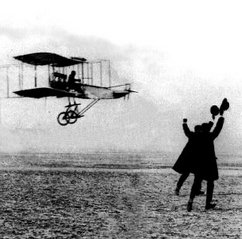
Henri Farman flies a complete 1-kilometer circle on 13 January 1908,
at Issy-les-Moulineaux outside Paris.
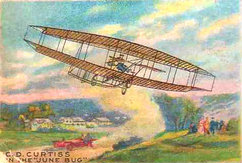
An old "tobacco card" showing Glenn Curtiss flying the
June Bug on 4 July 1908 near
Hammondsport, New York.
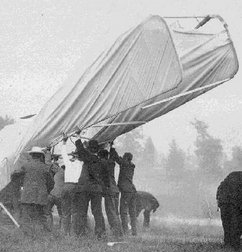
Just after the crash of the Wright Military Flyer at Fort Myer,
Virginia on 17 September 1908.
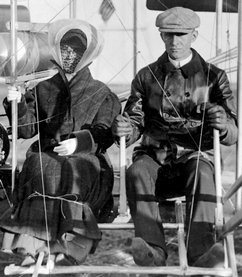
Wilbur Wright about to take his sister Katharine aloft at Le Mans,
France in 1909.
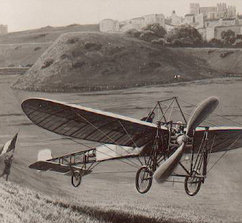
An illustration of Bleriot landing at Dover, England after crossing
the English Channel on 19 July 1909.
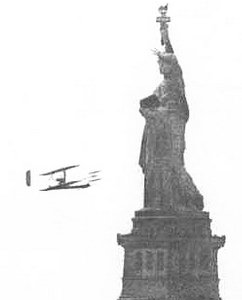
Wilbur Wright flying around the Statue of Liberty in New York Harbor
on 29 September 1909.
|

